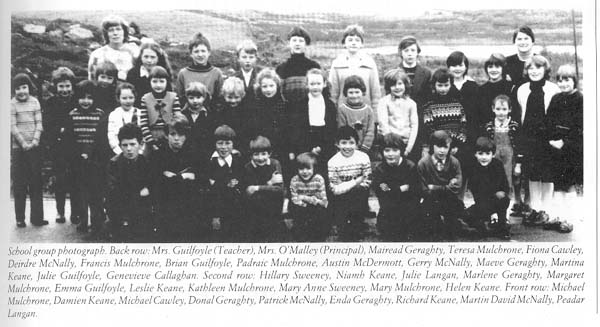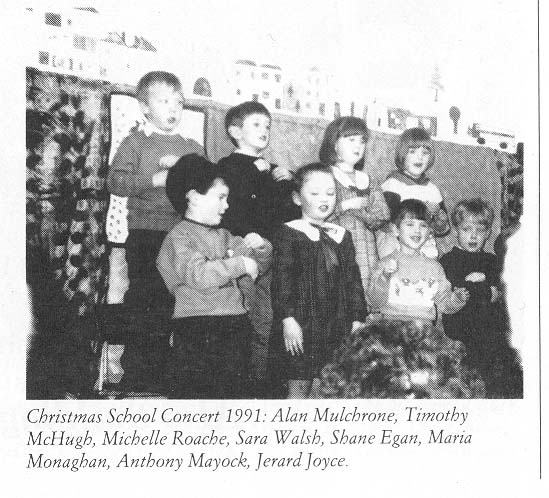
OFTEN, in imagination, I walk again through the door of Cuilmore School. I think of it in winter, when the whins are covered with cobwebs, and the ice has etched fern patterns on the lower half of the window. Dominic Geraghty is standing with his back to the fireplace, positioning a blackboard so that it will create an updraught.
That early in the morning we start our day with Headline copies, red lines and blue lines. Each headline will be painfully etched with a halfpenny nib, which will become cross-legged and spit and blob. The ink wells situated in the centre of our solid two-seater wooden desks will be refilled each week. Blue powder mixed with water serves as ink. Doled out with tablespoons, it also serves to cover the dents in the navy-blue walls, the ink soaking quickly into the loose mortar.
Lunch break in Autumn is an exciting trading session. The apples are in, and Callaghans have the best apples. They can trade 1 for 2 from any other orchard. "You promised me yesterday' and "you said we had a deal" is muttered sourly. Many calves are sold nowadays at marts with less haggling.
On fine days we were released into the play- ground. It was strictly divided into the girls yard and the boys yard. This division only fell on days when we played joined tip and the whole school united in one long line of screaming humanity, chasing the last errant pupil who had managed to escape the net. True summer saw us playing wheelbarrows (forbidden, because it tore all dresses), cockfighting (forbidden because i~t was dangerous), escaping to the sliding rock (forbid- den because it was outside the school grounds and it tore knees and trousers with equal ease).

Winter, saw us confined to the long hallway. There we played Dallog, slipping and sliding on damp floors covered in mashed lunch time crumbs. The only real means of escape in Dallog was to go to the cloakroom, climb on the coat hooks covering your feet with a coat.
There were highlights too in our routine. Our favourite, perhaps, was the Christmas party. The menu was simplicity itself -dozens of white sliced loaves, strawberry jam and canned sweets for afters. The "Punch and Judy" show also paid us an annual visit an the lady with the bells arrived, unloading an enormous bag. She lined the bells out on the teachers table. You could hear the sound of suspended breathing as she went through her routine.. Then there was the catechism exam. We dressed in our best and we worried about that all important question "What is sanctifying Grace? and "How many kinds of sin are there?" Fr. Tobin relaxed in his chair, ran his hands over his wavy black hair and said softly "Good child." Those who had answered cor- rectly beamed while whose who waited their turn scowled or fidgeted.
Our eyesight was checked in the boys cloak- room, and we stood in line for vaccinations, Polio, T.B., B.C.G. We were all brave soldiers when the need arose. Yet, the smell of burning metholated spirits used then to sterilise needles can still make us feel quite faint.
Summer brought a feeling of freedom. The road home was shorter. The telephone wires hummed louder and the crickets fell silent as your footsteps approached. Wild strawberries grew on the comer of the Lough Road. The meadows (in pre- fertilizer days) were a mass of colour. Two days before the Corpus Christi procession in Newport, huge wicker baskets arrived from the Convent. We ran through the fields collecting armfuls of wild flowers. The classroom became a meadow as the stalks were beheaded. Finally, the baskets full of flowers were prettily decorated, admired and shipped in the boot of the car to the Lace room in the Convent.
There was a craft class too. The boys did cane work, stools, trays, while we girls bleached flour bags, pulled threads, embroidered and produced tray cloths. Any hole in the fabric ,of the tray cloth was disguised as a daisy with a white centre. I still have my tray cloth and it has quite a number of daisies.
The poetry we learned there, we learned for life. We mourned the Croppy Boy:
"Sinte ar Thaobh an Sleibhe
Chonaic me an Croppy bocht
Bhi an druacht go trom ar a headain
Is bhi pilear tren a h-ucht."
On the final line it was important to compete to knock the loudest sound from your chest bone.
Or how about the conversation between St. Patrick and Oisin.
"What kept you Oisin
Noble in days of Yore?
Hands that were strong
Hearts that were pure
And lips that spoke no lie."
I saw it all through the eyes of child. I know the moods of the lake, the smell of the cloakroom, the spot where the yellow alpines grow close to the rocky ground. I hear the sing-song voices learning tables and the shrill scream of the seagulls as they dive in the school yard for the discarded crusts of bread.
But for me, it is no more, for the child that was lives only in imagination. ...
"Things bright and green
Things young and beautiful.. .
And I have gone upon my way, sorrowful. .."
